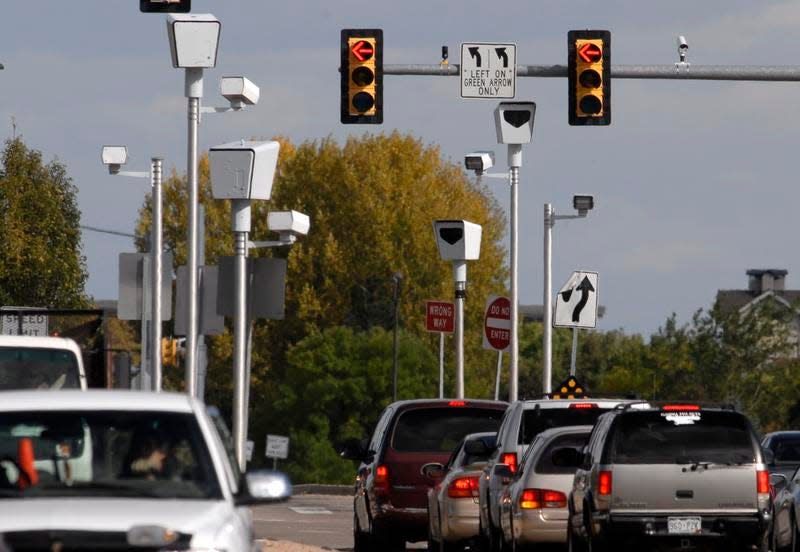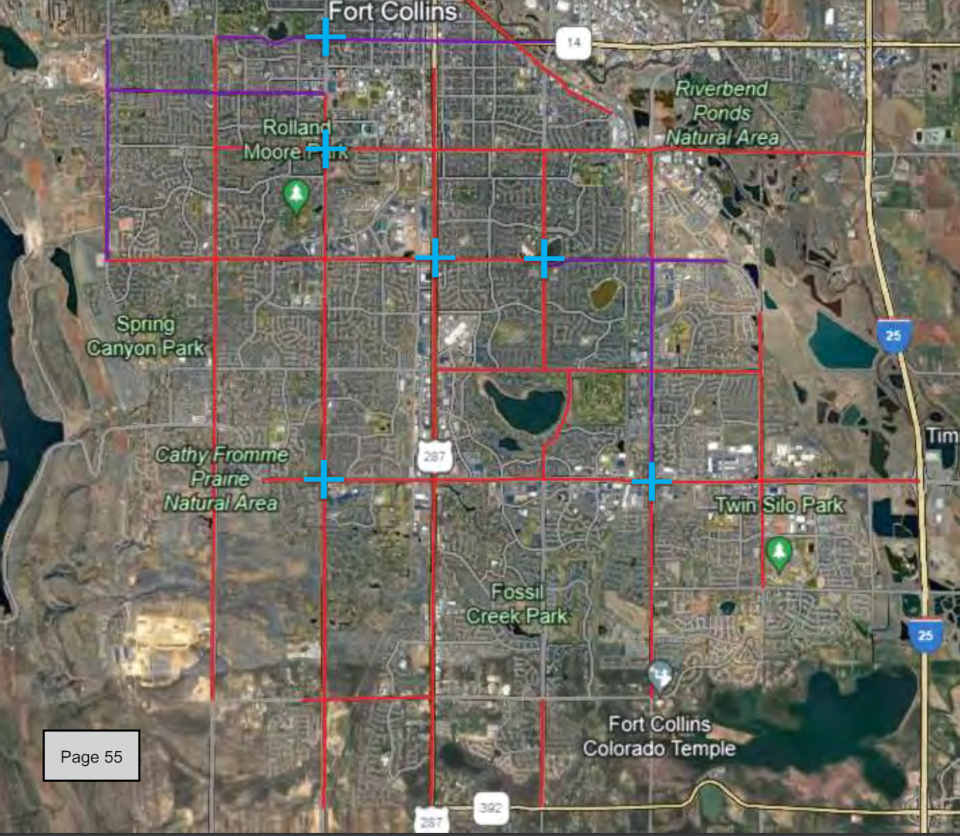Fort Collins to use red-light traffic cameras for speeding tickets
Fort Collins drivers, depending on how fast you drive, you might be more likely to get a speeding ticket after the city expands its use of unmanned photo speed enforcement later this year.
Fort Collins already has cameras at six major intersections that catch drivers when they run through red lights. Soon, the city will be able to use those same cameras to catch drivers speeding 11 mph or more.
So what's behind this change?
A Colorado law passed in 2023 allows local governments to expand their use of photo ticketing systems (known as AVIS, or automatic vehicle identification systems) to any road that they designate as a speed corridor. Without that designation, these cameras can be used only in construction zones, school zones, neighborhoods and along roads that are adjacent to parks.
Fort Collins already uses cameras for speeding enforcement in these instances.

In presentations to City Council, Fort Collins Police Services representatives said the goal is to improve safety on roads.
They say Fort Collins saw a record number of traffic fatalities in 2023 and the program will help the city achieve its stated goal of eliminating all deaths and serious injuries due to traffic crashes. That goal is part of the city' strategic plan known as Vision Zero.
Data presented to council by Fort Collins Police Services Lt. Jerrod Kinsman before his recent retirement showed injury crashes more than doubled in Fort Collins since 2019, going from 277 to 648 in that time.
Bike and motorcycle crashes that caused serious injury or death were up 45% in 2023, according to previous Coloradoan reporting.
"Last year, the city experienced a record-high number of fatal and injury collisions, many of which were associated with people driving beyond posted speed limits," city staff stated in its presentation to council.
City Council unanimously consented to the program and funding for it for the rest of 2024, along with the proposed speed corridors, at its July 2 meeting. A final vote is set for July 16.
The city expects implementation of the new program by October, according to documents presented to City Council.
"I think the tickets will probably go up and then the behavior will start changing," Mayor Jeni Arndt said in announcing her support for the changes at the July 2 meeting. "That's what we're really going for."
Where can a camera catch you speeding in Fort Collins?
Within designated speed corridors, and most sections of the city's most traveled roads fall within one. Cameras can also be used in construction zones, school zones, neighborhoods and along roads that are adjacent to parks.

The six intersections fitted with the cameras used for red-light violations are located within the new designated speed corridors.
There are also plans for two moveable units that could be placed at any location within any speed corridor.
Here's where the speed corridors are located:
Intersection of Mulberry Street and Shields Street
Intersection of Prospect Road and Shields Street
Intersection of Harmony Road and Shields Street
Intersection of Drake Road and College Avenue
Intersection of Drake Road and Lemay Avenue
Intersection of Harmony Road and Timberline Road
Riverside Avenue from Pitkin Street to College Avenue
Prospect Road from Taft Hill Road to Interstate 25
Drake Road from Overland Trail to Lemay Avenue
Horsetooth Road from College Avenue to Ziegler Road
Harmony Road from Chokecherry Trail to Interstate 25
Trilby Road from Wainwright Drive to College Avenue
Taft Hill Road from Mulberry Street to Trilby Road
Shields Street from Elizabeth Street to Carpenter Road
College Avenue from Laurel Street to Carpenter Road
Lemay Avenue from Prospect Road to Trilby Road
Timberline Road from Prospect Road to Drake Road
Timberline Road from Harmony Road to Trilby Road
Ziegler Road from William Neal Parkway to Kechter Road
Conifer Street from College Avenue to Lemay Avenue
Mulberry Street from Taft Hill Road to 12th Street
Stuart Street from College Avenue to Lemay Avenue
Elizabeth Street from Overland Trail to Shields Street
Drake Road from Lemay Avenue to Miles House Avenue
Overland Trail from Mulberry Street to Drake Road
Timberline Road from Drake Road to Harmony Road
Who decides what qualifies as a speed corridor?
Speed corridors are determined based on data collected over a maximum of five years that show the most prevalent locations for crashes involving injuries and deaths; speed violations of 20 mph or more; citations for things like careless or reckless driving and racing; and community complaints.
City Council approved the staff-recommended speed corridors listed above at the July 2 meeting. Council will receive updates on the outcomes every two years and can change the corridors based on the new data.
How much money does the city expect to collect from citations?
Since 2021, the city has collected more than $1 million annually from its existing photo enforcement programs.
The city expects to see an additional $2 million to $3.4 million in funds annually through the new program.
How will the money from fines be used?
There will be significant revenue from the program. In fact, the city estimates AVIS citations will increase 133% once the speed corridors are added.
But city staff also expect this bump to increase the burdens on municipal court and the city attorney's office. So, revenue from the fines will go toward funding additional employees in each of those departments to handle the surge.
Funds will also go to support implementing the city's Vision Zero strategic plan, which could include traffic safety initiatives, projects, equipment and services, city documents state. That includes hiring a Vision Zero coordinator.
Costs for the technology
Upgrading red-light cameras to detect speeding: $360,000 annually
Adding two mobile detection units: $204,000 annually
Total additional system costs: $564,000 annually
Costs for personnel
For 2025 and beyond:
2 full-time municipal court clerks: $154,000
1 city attorney and 1 legal assistant: $253,000 (City Attorney’s Office)
Temporary staffing in municipal court: $59,000
Temporary staffing in city attorney's office: $259,000
Network engineer: $117,000
Vision Zero coordinator: $131,000
What is the worst intersection for speeding?
Data from the city's existing red-light cameras can track the number of people speeding 11 mph or more over the posted speed limit. On average each month, here's how many people did that (data from 2019 to 2023):
Shields and Prospect: 16,192
Harmony and Shields (2024 data only): 2,892
Drake and Lemay (2024 data only): 1,006
Drake and College: 855
Mulberry and Shields: 412
Harmony and Timberline: 339
This article originally appeared on Fort Collins Coloradoan: Fort Collins expanding camera speeding enforcement in 2024

